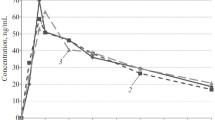Summary
The effects of alprenolol on heart rate and systolic blood pressure were studied in healthy subjects during standardized exercise on a bicycle ergometer. In one series of experiments, in which serum concentrations of alprenolol were also measured, the effects of single oral doses of 50, 100 and 200 mg of alprenolol and a placebo were compared by a double blind cross-over technique. In a second series of experiments 100 mg alprenolol was given four times in one day and the effect was followed for up to eighteen hours after the last dose. — Alprenolol diminished the expected increase in heart rate and systolic blood pressure during exercise. The reduction of exercise tachycardia in a given individual was linearly related to the logarithm of the dose or the serum concentration of alprenolol. The serum concentrations required for a given reduction of exercise tachycardia varied almost one hundred-fold amongst the subjects studied. The biological availability of alprenolol was dose-dependent, probably due to a limited capacity biotransformation of the drug before it entered the general circulation. After a single dose the serum level of alprenolol and its chronotropic effect diminished at a rate corresponding to an elimination half life of about two hours. This rate of elimination was consistent with that calculated from the results of the four dose study.
Similar content being viewed by others
References
Åblad, B., Johnsson, G., Norrby, A., Sölvell, L.: Potency and time-effect relationship in man of propranolol and H 56/28 — comparative studies after oral administration. Acta pharmacol. toxicol.25, Suppl. 2, 85–94 (1967a).
—— Brogard, M., Ek, L.: Pharmacological properties of H 56/28 — a β-adrenergic receptor antagonist. Acta pharmacol. toxicol.25, Suppl. 2, 9–40 (1967b).
Ågren, A., Elofsson, R., Meresaar, U., Nilsson, S.O.: Complex formation between macromolecules and drugs. III. A study of the influence of ionic strength and pH. Binding between Aptin®, nortriptyline, sulfamethizole or tripelenamine and serum albumin, poly-arginine, poly-lysine, polyornithine, protamine or dextran sulfate. Acta pharm. Suec.7, 105–112 (1970).
Brick, I., Hutchison, K.J., McDevitt, D.G., Roddie, I.C., Shanks, R.G.: Comparison of the effects of I.C.I. 50172 and propranolol on the cardiovascular responses to adrenaline, isoprenaline and exercise. Brit. J. Pharmacol.34, 127–140 (1968).
Carlsson, E., Åblad, B., Carlsson, B., Johansson, R., Wallin, B. 1972. To be published.
Ervik, M.: Gas chromatographic determination of the secondary amine alprenolol, as its trifluoroacetyl derivative, at nanogram levels in biological fluids. Acta pharm. Suec.6, 393–400 (1969).
Gustavii, K., Brändström, A., Allansson, S.: Ion pair extraction in preparative organic chemistry. Part VII. Separation and purification of amines from reaction mixtures. Acta chem. scand.25, 77–84 (1971).
Johansson, R., Regardh, C.G., Sjögren, J.: Absorption of alprenolol in man from tablets with different rates of release. Acta pharm. Suec.8, 59–70 (1971).
-- Obianwu, H.O., Bodin, N.-O., Svensson, R., Borg, K.-O.: Absorption, distribution, and excretion of 1-(0-allylphenoxy)-3-isopropylamino-2-propanol (alprenolol) in man, dogs and rats. 1972. To be published.
Johnsson, G., Norrby, A., Sölvell, L.: Potency and time-effect relationship in man of propranolol and H 56/28. I. Comparative studies after intravenous administration. II. Studies on the ratio of equipotent oral and intravenous doses. Acta pharmacol. toxicol.25, Suppl. 2, 95–105 (1967).
—— de Guzman, M., Bergman, H., Sannerstedt, R.: The haemodynamic effects of alprenolol and propranolol at rest and during exercise in hypertensive patients. Pharmacologia Clinica2, 34–39 (1969).
—— Sjögren, J., Sölvell, L.: Beta-blocking effect and serum levels of alprenolol in man after administration of ordinary and sustained release tablets. Europ. J. clin. Pharmacol.3, 74–81 (1971).
Levy, G.: Kinetics of pharmacologic effects. Clin. Pharmacol. Ther.7, 362–372 (1966).
Robinson, B.F., Epstein, S.E., Beisa, G.D., Braunwald, E.: Control of heart rate by the autonomic nervous system. Circulation Res.19, 410–411 (1966).
Söderholm, B.: β-Receptorblockerares effekt pa cirkulationen i vila och under arbete hos patienter med angina pectoris (1969). In Angina Pectoris, eds. Varnauskas, E., Werkö, L., Göteborg, 215–220 (1969).
Author information
Authors and Affiliations
Rights and permissions
About this article
Cite this article
Åblad, B., Ervik, M., Hallgren, J. et al. Pharmacological effects and serum levels of orally administered alprenolol in man. Eur J Clin Pharmacol 5, 44–52 (1972). https://doi.org/10.1007/BF00560895
Received:
Accepted:
Issue Date:
DOI: https://doi.org/10.1007/BF00560895




